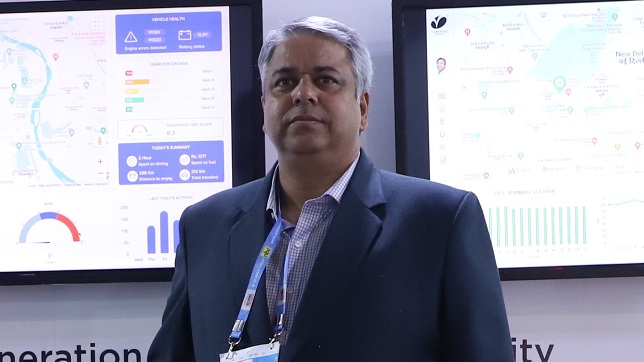Telematics-based insurance and its adaptability in the Indian market

Sagar Apte, CEO, Varroc Connect shared his views with Telematics Wire on regulatory approval for telematics-based insurance and its adaptability in the Indian market.
Can you mention in brief about Varroc Connect?
The world is experiencing interesting times with connected devices redefining how human beings interact with the ecosystem.
Varroc Connect is striving to help OEMs bring managed connectivity to their vehicles. This would mean a lot of solutions and advanced Products working together to bring a cohesive experience. These could be categorized into the following three broad buckets:
- Convenience – Features such as remote lock/unlock, remote lights on/off, and remote starting the car and operating the AC
- Vehicle health check – View car health dashboard and alerts about critical car parameters, including battery-related alerts
- Safety and security – FOTA and COTA allow OEMs to remotely manage and update software in the vehicles. SOS SMS to an emergency contact in case of an accident and remote immobilization when the car is stolen are other critical uses cases that will help promote safe driving.
How do you think the regulatory approval for telematics-based insurance will be beneficial for vehicle owners?
- IRDAI has permitted general insurance companies to introduce tech-enabled concepts, such as Pay as You Drive and floater policies for vehicles belonging to the same individual owner for two-wheelers and private cars, among others
- Now, as a step towards facilitating technology-enabled covers, IRDAI has permitted general insurance companies to introduce tech-enabled concepts for own damage (OD) cover in motor insurance policies
- Many do not drive as frequently as before but still have to pay the same established annual premium based on the model of their vehicle
- Every individual has different driving and vehicle usage patterns, and with the new add-ons permit, own damage policy coverage can now be tailored based on a customer’s driving behaviour patterns, general upkeep, mileage, and vehicle usage patterns to offer the best features they need
- The premium will be determined as per an individual’s tailored coverage
- Therefore, opting for the Pay as You Drive or Pay How You Drive add-on in addition to the traditional policy will benefit those customers who have low vehicle usage, take care of their vehicles, follow traffic rules, and maintain good driving behaviour
- Customers will not have to pay standard premium going forward
- Telematics used at Varroc Connect has a robust API to integrate into the existing insurance platforms, which will help with efficient data exchange benefitting both insurance companies and consumers
- Alerts for rash car driving feature embedded in the application will further help the customers
Do you see a reduction in insurance premiums resulting in big volumes for insurance companies?
Safe drivers should definitely benefit from this. We have seen in other countries the larger adoption due to the flexibility and transparency that telematics brings to motor insurance.
What could be the biggest challenge for the insurance companies and regulatory agency in implementing this?
A new Product have to be calibrated for the final end users. Customers will definitely see benefits and working towards assuring them of the value in this program is going to be the key requirement. Insurance companies will have to work to educate the buyers of these products and that I think is going to the key focus in the next few years.
Would you like to share your views about data security?
Data security is critical and India is working towards implementing laws that will make these more stringent. Good companies will always welcome these changes. We at Varroc Connect have taken a special interest in developing Products that will protect the data rights of the users.
Where do you see the automotive insurance sector in the coming years with technologies like automotive telematics, ADAS, and autonomous vehicle bringing some disruption?
- The market for connected cars is predicted to soar to over $215 billion by 2027
- Connected cars are potentially safer for road users, and less harmful to the environment
- They open up new revenue streams for the car industry with features such as remote diagnostics, predictive maintenance and online service scheduling
- They also present the car industry with an opportunity to innovate and create stronger relationships with its customers than ever before
- Improved Safety: The introduction of ‘vehicle-to-everything‘ communications enables a more direct flow of information between vehicles, pedestrians and road infrastructure. This means that drivers will be alerted to nearby hazards, such as broken-down vehicles, reducing the chance of accidents. It has the potential to improve road safety around the world significantly.
- Consumer Experience: Driver demand for connectivity is increasing as people become more familiar with the benefits of staying connected. According to McKinsey, 40% of consumers would change car brands to gain more connectivity within their vehicles
- Environmental Benefits: As well as improving road safety, many of the key features of 5G-enabled vehicle-to-everything technology could also help to manage traffic congestion in major cities. Vehicle-to-infrastructure communication enables direct communication channels between a vehicle and nearby road infrastructure without need to connect through a central mobile network
- Alternative revenue streams for automakers: 5G also presents a huge revenue opportunity for automakers that goes beyond just the point of sale. It will allow manufacturers to create lasting connections with customers by offering additional features such as remote diagnostics, predictive maintenance and online service scheduling – all of which would not be possible without integrated connectivity.
Published in Telematics Wire




